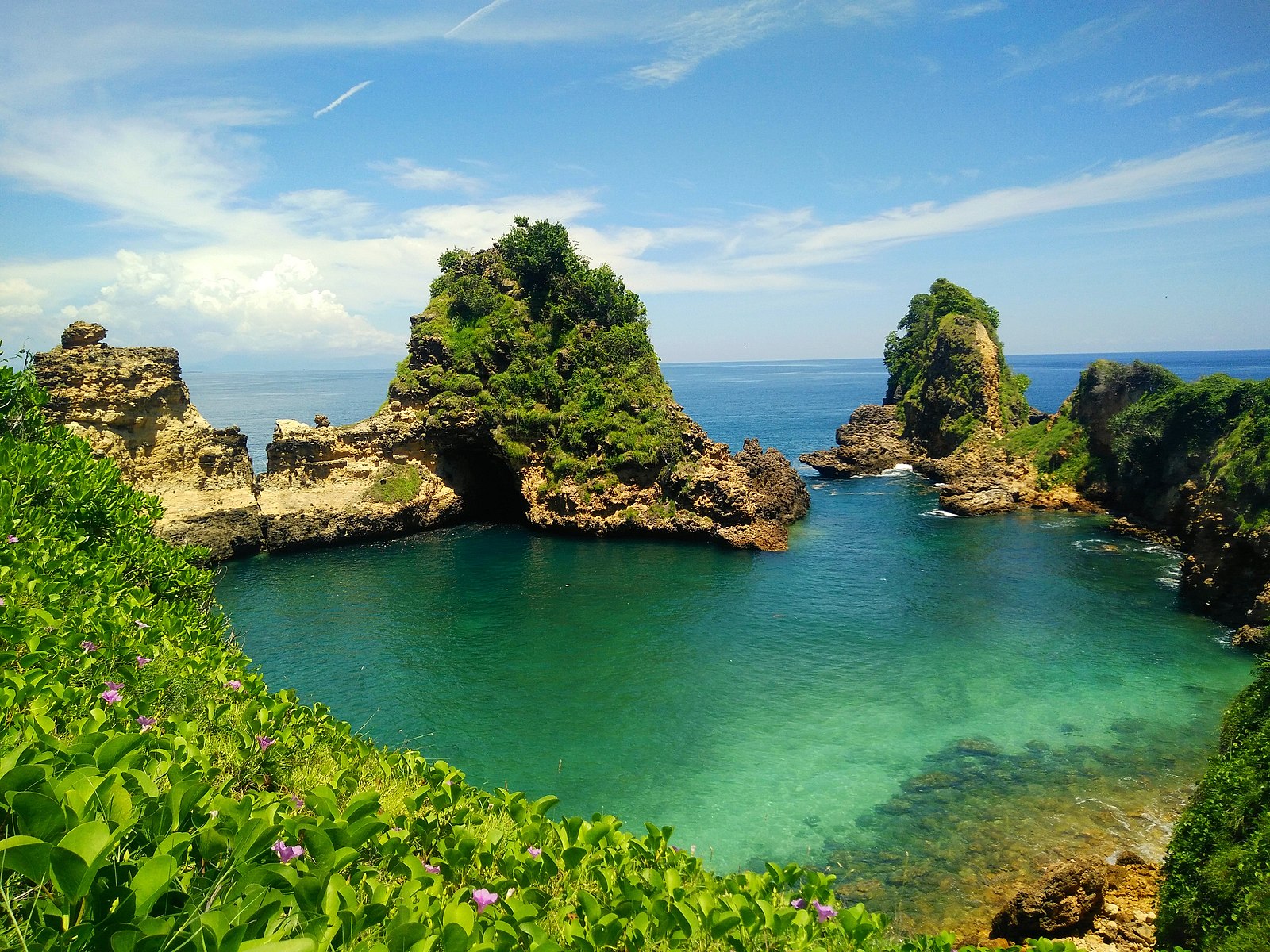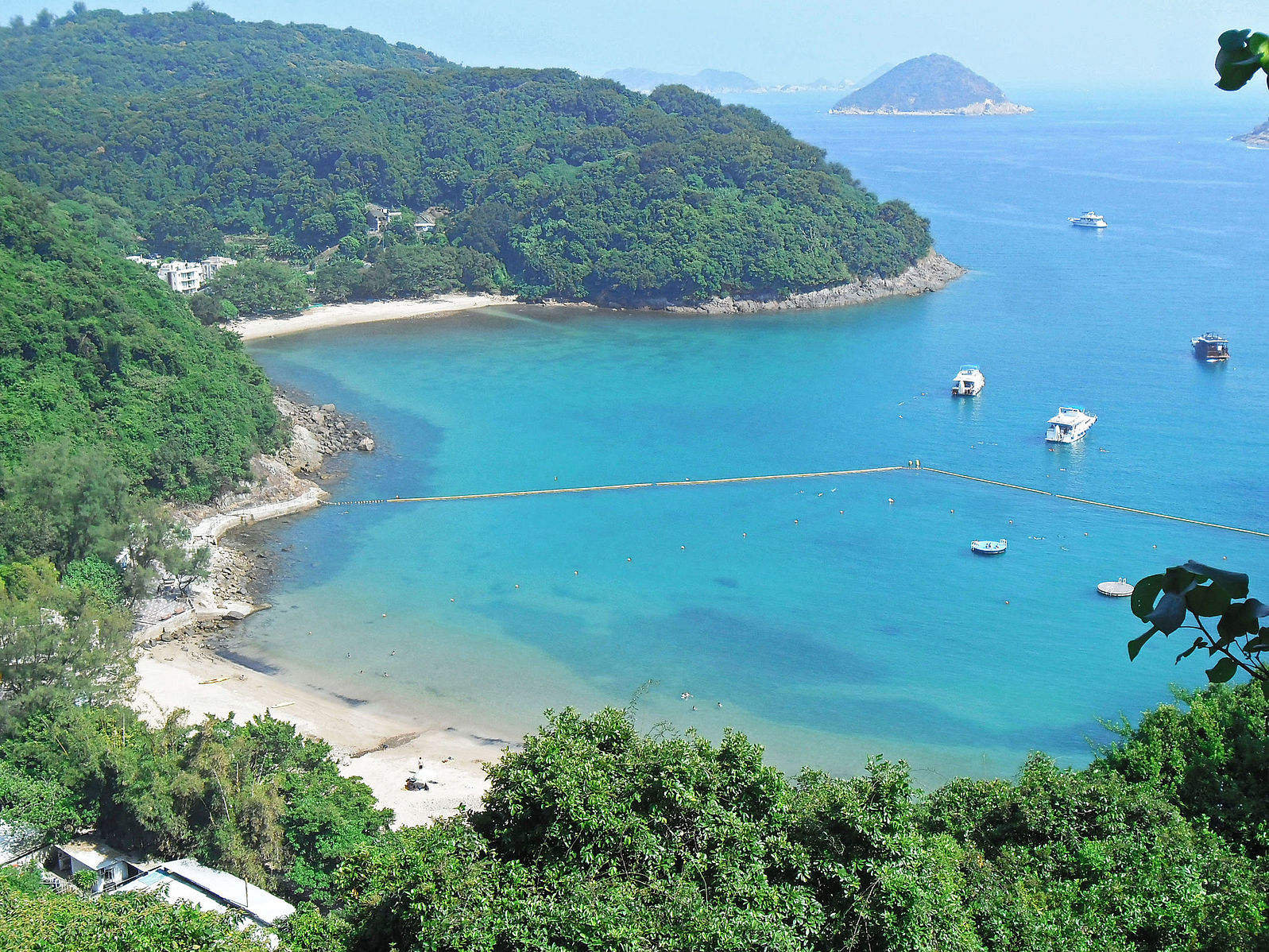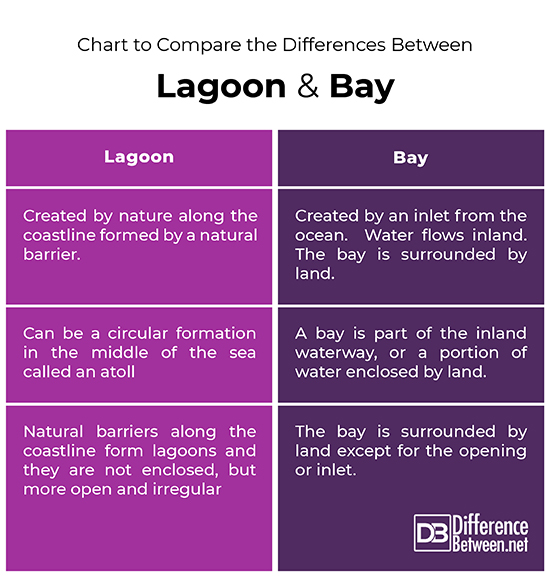Difference Between Lagoon and Bay
When you think of a lagoon or a bay your mind immediately connects with water as these two words are related to water formations. However, the way the water is geographically balanced is different. Lagoons are attached to holidays and pleasant vistas by the sea. A bay, although connected to water, has more land surrounding it and therefore is more sheltered. A lagoon is defined by the reef or rocks that separate it from the open sea.

The Definition of a Lagoon
A lagoon is usually shallow and it is separated from a larger body of water by a reef of some sort or barrier islands that keep the shallow water together. The lagoon is fed by a greater body of water and fill up with the tides as it is affected by the tide going in and out. The reef or line of rock, or a sand bank, acts as a buffer from the sea. A lagoon forms along a coastline and is sensitive to how the sea level rises and falls. The word lagoon comes from the Italian word, laguna, meaning pond or lake.
How a Lagoon is formed
Lagoons are created through different changes in the shoreline, or from the sea, a larger body of water outside the lagoon. There are various natural factors that can cause this formation, and that may simply be the deposit of sand over the years. The barrier may be created by coral reef formations, storms or even catastrophic events like hurricanes or a Tsunami. There are two types of lagoons a coastal lagoon and an atoll lagoon. Coastal lagoons can vary in depth and be swampy if the sea level is low. If the sea level is high, they may look like lakes or bays and this is why they may be confused with a bay.
Atoll lagoons are protected by coral reefs growing from volcanic islands that may have sunk beneath the sea. An atoll lagoon looks different, because it forms a circle of smaller islands or coral reef formations, around the lagoon in the middle.
What you will find in a Lagoon
Lagoons can have different kinds of water such as salt water, fresh water if they are part of a river system like the Kerala system, or water that is swampy or brackish. The most common is the saltwater lagoon. Each lagoon will have its own ecosystem and that ecosystem depends on the type of water and plants in the lagoon. Lagoons provide the best habitat for spawning and for every kind of aquatic creature you can imagine. A lagoon provides the habitat for all kinds of marine plant and animal life such as fish, snails, crustaceans, and clams.

The Definition of a Bay
A bay connects with another larger body of water. There is a narrow inlet of water leading into the larger collection of water surrounded by land. A large bay is known as a gulf or sound, and a smaller bay would be referred to as a cove. The common factor is all bays have an inlet of water and are surrounded by a large curve of land that creates the bay. The mouth or opening of a larger bay connects to the sea allowing ships to sail in and out of the bay.
How a bay is formed
A bay may be formed by erosion of the coast or by the harsh waves crashing on bands of soft rock. Many bays were formed by a process known as plate tectonics which is when continents and bodies of land drift away from each other. There are different types of bay formation. A fjord is a bay formed after a glacier crash through the bed rock of a canyon. When the glacier moves away the sea fills the gap made by the glacier. A bay called a ria is formed in an estuary. The sea takes over the estuary and it becomes known as a ‘drowned river’. A bay connects with the sea and allows water to come in through the inlet leading to the sea, but it is surrounded by land.
The Bay of Bengal is the largest bay in the world and is found in the Indian Ocean. Bays have played an important role in providing shelter for ships from the rough sea outside the bay. Sailors in days gone by relied on bays to give them a calm place to anchor their ships and explore the interior of new lands.
What you will find in a bay
Habitats and creatures found in a bay may vary depending on where the bay is found. There may be wetlands surrounding parts of the bay. The depth of the bay and the quality of the water can affect the ecology of the bay. There are fish and birds as well as plants like underwater grasses. Many of the habitats found in a bay depend on the conservationists and the ecologists who strive to keep each bay a healthy environment for plants and wildlife.
FAQ: Here are some Frequently Asked Questions answered for you.
Is a bay a lagoon?
A bay, geographically speaking, is not a lagoon. These two terms are confused because of their similarity in terms of a water formation fed by other greater portions of water. However, the clear difference is a bay has land all round it with an inlet, while a lagoon is created along coastlines by coral reef formations or volcanic islands, sand banks and other changes in the geography of the area.
What makes a lagoon?
Lagoons are made from natural barriers that separate water from a large body of water like the sea. The natural barriers could be made of sandbars, coral reefs, barrier reefs or other barriers formed by nature. Lagoons called atolls are formed out of a circle of smaller islands or coral reefs or even volcanic formations that are in the sea. An atoll is not usually on the coastline.
Are backwaters and lagoons the same thing?
A backwater is not the same as a lagoon. Backwaters are formed in part of a river where the current of the river has slowed down due to a blockage in the river. The flow of the river slows down, and the water backs up. The river could be flowing into the sea, or it could be a part of a larger river. The slowing down of the river flow causes the backwater. This is not the way a lagoon is formed.
Why is it called backwaters in Kerala?
These backwaters are a long network of islands and waterways connected by a system of lakes, canals, rivers and even lagoons. It is a massive waterway with five large lakes, canals, and rivers. It is known as a backwater because of the waterways that connect with each other over the whole Kerala area. They are all interconnected and therefore it is easier to call it all a backwater and not individualise each different type of waterway within the network. The backwaters of Kerala facilitate travel and commercial opportunities.
Are backwaters deep?
Backwaters can differ according to their formation and the amount of water flowing into them. Some backwaters may be isolated tranquil shallows of a river. Other backwaters like the Kerala may be deep in parts because they are made up of rivers and lakes. House boats and other aquatic transport can be part of these waterways.
Chart to compare the differences between Lagoon and Bay:

Summary:
A lagoon and a bay may easily be confused until you understand the basic formation of these two bodies of water. The lagoon is the coastal smaller body of water from the ocean protected by a barrier of coral, rock formation or a sandbank. A bay is surrounded by a land formation. Lagoons appear more diverse and even exist as atolls. A bay is easier to define by the land surrounding it and the inlet bringing in the water. Lagoons and bays provide holiday and recreational facilities, but a lagoon has a more romantic holiday feel as you think of palm trees waving over blue waters and soft sand.
- Difference Between Lagoon and Bay - October 20, 2021
- Difference Between Futurism and Preterism - August 12, 2021
- Difference Between Dichotomy and Paradox - August 7, 2021
Search DifferenceBetween.net :
 Email This Post
: If you like this article or our site. Please spread the word. Share it with your friends/family.
Email This Post
: If you like this article or our site. Please spread the word. Share it with your friends/family.
1 Comment
Leave a Response
References :
[0]Solyst Jake. Oct. 6th 2020. www.chespeakebay.net. Habitats found in the Chesapeake bay. Pub Chesapeake Bay Program.
[1]Cook Sharell. Oct 24th 2020. www.tripsavvy.com The Kerala Backwaters and how best to visit them. Pub. Dotdash publishing company.
[2]Holmgreen Lynn. March 13th 2018 www.sciencing.com Differences between Bodies of Water. Pub Leaf Group Media.
[3]Image credit: https://commons.wikimedia.org/wiki/File:Clear_Water_Bay_1st_Beach.jpg
[4]Image credit: https://commons.wikimedia.org/wiki/File:Sari_Goang_beach_lagoon,_Lombok.jpg


thankyou